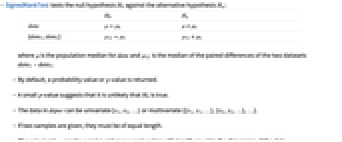SignedRankTest[data]
tests whether the median of data is zero.
SignedRankTest[{data1,data2}]
tests whether the median of data1-data2 is zero.
SignedRankTest[dspec,μ0]
tests a location measure against μ0.
SignedRankTest[dspec,μ0,"property"]
returns the value of "property".


SignedRankTest
SignedRankTest[data]
tests whether the median of data is zero.
SignedRankTest[{data1,data2}]
tests whether the median of data1-data2 is zero.
SignedRankTest[dspec,μ0]
tests a location measure against μ0.
SignedRankTest[dspec,μ0,"property"]
returns the value of "property".
Details and Options



- SignedRankTest tests the null hypothesis
 against the alternative hypothesis
against the alternative hypothesis  :
: -


data 

{data1,data2} 

- where μ is the population median for data and μ12 is the median of the paired differences of the two datasets
 .
. - By default, a probability value or
 -value is returned.
-value is returned. - A small
 -value suggests that it is unlikely that
-value suggests that it is unlikely that  is true.
is true. - The data in dspec can be univariate {x1,x2,…} or multivariate {{x1,y1,…},{x2,y2,…},…}.
- If two samples are given, they must be of equal length.
- The argument μ0 can be a real number or a real vector with length equal to the dimension of the data.
- SignedRankTest assumes that the data is symmetric about the median in the univariate case and elliptically symmetric in the multivariate case. For this reason, SignedRankTest is also a test of means.
- SignedRankTest[dspec,μ0,"HypothesisTestData"] returns a HypothesisTestData object htd that can be used to extract additional test results and properties using the form htd["property"].
- SignedRankTest[dspec,μ0,"property"] can be used to directly give the value of "property".
- Properties related to the reporting of test results include:
-
"DegreesOfFreedom" the degrees of freedom used in a test "PValue" list of  -values
-values"PValueTable" formatted table of  -values
-values"ShortTestConclusion" a short description of the conclusion of a test "TestConclusion" a description of the conclusion of a test "TestData" list of pairs of test statistics and  -values
-values"TestDataTable" formatted table of  -values and test statistics
-values and test statistics"TestStatistic" list of test statistics "TestStatisticTable" formatted table of test statistics - The SignedRankTest is a more powerful alternative to the SignTest.
- For univariate samples, SignedRankTest performs the Wilcoxon signed rank test for medians of paired samples. A correction for ties is applied for permutation-based
 -values. By default, the test statistic is corrected for continuity and an asymptotic result is returned.
-values. By default, the test statistic is corrected for continuity and an asymptotic result is returned. - For multivariate samples, SignedRankTest performs an affine invariant test for paired samples using standardized spatial signed ranks. The test statistic is assumed to follow a ChiSquareDistribution[dim] where dim is the dimension of the data.
- The following options can be used:
-
AlternativeHypothesis "Unequal" the inequality for the alternative hypothesis MaxIterations Automatic max iterations for multivariate median tests Method Automatic the method to use for computing  -values
-valuesSignificanceLevel 0.05 cutoff for diagnostics and reporting VerifyTestAssumptions Automatic what assumptions to verify - For the SignedRankTest, a cutoff
 is chosen such that
is chosen such that  is rejected only if
is rejected only if  . The value of
. The value of  used for the "TestConclusion" and "ShortTestConclusion" properties is controlled by the SignificanceLevel option. This value
used for the "TestConclusion" and "ShortTestConclusion" properties is controlled by the SignificanceLevel option. This value  is also used in diagnostic tests of assumptions including a test for symmetry. By default,
is also used in diagnostic tests of assumptions including a test for symmetry. By default,  is set to 0.05.
is set to 0.05. - Named settings for VerifyTestAssumptions in SignedRankTest include:
-
"Symmetry" verify that all data is symmetric
Examples
open all close allBasic Examples (4)
Test whether the median of a population is zero:
Compare the median difference for paired data to a particular value:
Report the test results in a table:
Test whether the spatial median of a multivariate population is some value:
Create a HypothesisTestData object for repeated property extraction:
Scope (13)
Testing (10)
The ![]() -values are typically large when the median is close to μ0:
-values are typically large when the median is close to μ0:
The ![]() -values are typically small when the location is far from μ0:
-values are typically small when the location is far from μ0:
Using Automatic is equivalent to testing for a median of zero:
The ![]() -values are typically large when median is close to μ0:
-values are typically large when median is close to μ0:
The ![]() -values are typically small when the location is far from μ0:
-values are typically small when the location is far from μ0:
Test whether the median vector of a multivariate population is the zero vector:
Alternatively, test against {0.1,0,-.5,0}:
The ![]() -values are generally small when the locations are not equal:
-values are generally small when the locations are not equal:
The ![]() -values are generally large when the locations are equal:
-values are generally large when the locations are equal:
The order of the datasets affects the test results:
Test whether the median difference vector of two multivariate populations is the zero vector:
Alternatively, test against {1,0,-1,0}:
Create a HypothesisTestData object for repeated property extraction:
The properties available for extraction:
Extract some properties from a HypothesisTestData object:
The ![]() -value and test statistic:
-value and test statistic:
Options (12)
AlternativeHypothesis (3)
MaxIterations (2)
Method (4)
SignificanceLevel (1)
Applications (1)
Properties & Relations (8)
The SignedRankTest is generally more powerful than the SignTest:
The univariate Wilcoxon signed rank test statistic:
In the absence of ties, Ordering can be used to compute ranks:
The asymptotic two-sided ![]() -value:
-value:
For univariate data, the test statistic is asymptotically normal:
For multivariate data, the test statistic follows a ChiSquareDistribution under ![]() :
:
The degree of freedom is equal to the dimension of the data:
For multivariate data, the SignedRankTest effectively tests uniformity about a unit sphere:
A function for computing the spatial signed ranks of a matrix:
Deviations from μ0 yield clustering of spatial signed ranks and larger test statistics:
The test statistic is affine invariant for multivariate data:
The signed rank test works with the values only when the input is a TimeSeries:
The signed rank test works with all the values together when the input is a TemporalData:
Possible Issues (1)
SignedRankTest requires that the data be symmetric about a common median:
Use SignTest if the data is not symmetric:
Related Guides
History
Text
Wolfram Research (2010), SignedRankTest, Wolfram Language function, https://reference.wolfram.com/language/ref/SignedRankTest.html.
CMS
Wolfram Language. 2010. "SignedRankTest." Wolfram Language & System Documentation Center. Wolfram Research. https://reference.wolfram.com/language/ref/SignedRankTest.html.
APA
Wolfram Language. (2010). SignedRankTest. Wolfram Language & System Documentation Center. Retrieved from https://reference.wolfram.com/language/ref/SignedRankTest.html
BibTeX
@misc{reference.wolfram_2025_signedranktest, author="Wolfram Research", title="{SignedRankTest}", year="2010", howpublished="\url{https://reference.wolfram.com/language/ref/SignedRankTest.html}", note=[Accessed: 18-December-2025]}
BibLaTeX
@online{reference.wolfram_2025_signedranktest, organization={Wolfram Research}, title={SignedRankTest}, year={2010}, url={https://reference.wolfram.com/language/ref/SignedRankTest.html}, note=[Accessed: 18-December-2025]}